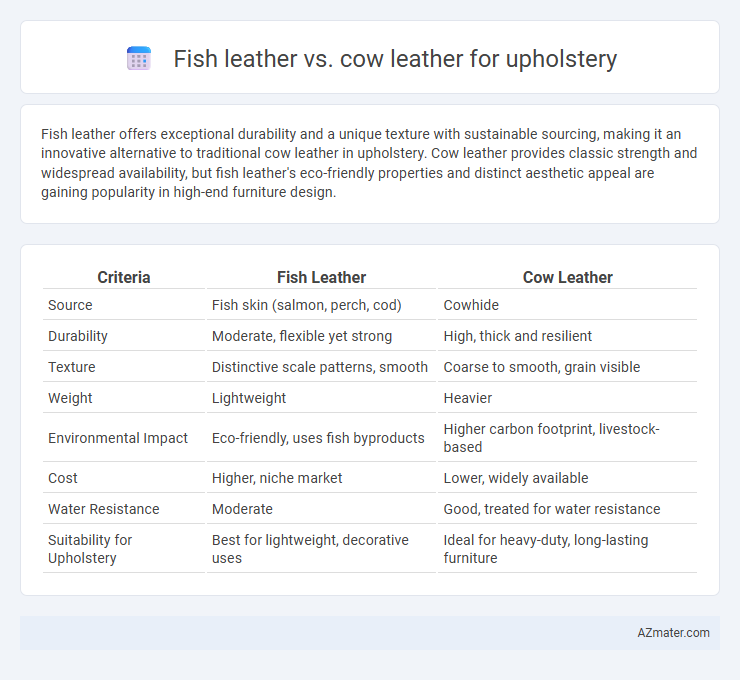Fish leather offers exceptional durability and a unique texture with sustainable sourcing, making it an innovative alternative to traditional cow leather in upholstery. Cow leather provides classic strength and widespread availability, but fish leather's eco-friendly properties and distinct aesthetic appeal are gaining popularity in high-end furniture design.
Table of Comparison
| Criteria | Fish Leather | Cow Leather |
|---|---|---|
| Source | Fish skin (salmon, perch, cod) | Cowhide |
| Durability | Moderate, flexible yet strong | High, thick and resilient |
| Texture | Distinctive scale patterns, smooth | Coarse to smooth, grain visible |
| Weight | Lightweight | Heavier |
| Environmental Impact | Eco-friendly, uses fish byproducts | Higher carbon footprint, livestock-based |
| Cost | Higher, niche market | Lower, widely available |
| Water Resistance | Moderate | Good, treated for water resistance |
| Suitability for Upholstery | Best for lightweight, decorative uses | Ideal for heavy-duty, long-lasting furniture |
Introduction to Fish Leather and Cow Leather
Fish leather, derived from the skins of species such as salmon, cod, and perch, offers a sustainable and biodegradable alternative to traditional cow leather used in upholstery. Cow leather, sourced from cattle hides, is renowned for its durability, flexibility, and long-lasting qualities, making it a prevalent choice in furniture manufacturing. The unique texture and eco-friendly properties of fish leather contrast with the established strength and availability of cow leather, influencing material selection based on environmental impact and aesthetic preferences.
Unique Properties of Fish Leather
Fish leather exhibits a unique combination of durability and flexibility, making it an excellent alternative to traditional cow leather for upholstery. Its fine grain structure provides a distinct texture that is both lightweight and highly resistant to stretching, while natural oils in fish leather offer enhanced water resistance and softness. These properties, coupled with its sustainability as a byproduct of the fishing industry, position fish leather as a premium choice for eco-conscious, innovative upholstery designs.
Cow Leather: Traditional Choice for Upholstery
Cow leather remains the preferred choice for upholstery due to its durability, natural flexibility, and ability to develop a rich patina over time. Its dense fiber structure provides excellent resistance to wear and tear, making it suitable for heavy-use furniture in both residential and commercial settings. Compared to fish leather, cow leather offers a more consistent texture and color range, meeting traditional design and comfort standards.
Durability Comparison: Fish Leather vs Cow Leather
Fish leather offers exceptional durability thanks to its unique collagen fiber structure, making it resistant to wear and tear, while also being thinner and more flexible than cow leather. Cow leather is traditionally prized for its robustness and longevity, often lasting decades in upholstery applications due to its dense grain and strength. Both materials provide durable options, but fish leather's natural water resistance and tensile strength create a competitive edge in certain upholstery environments.
Aesthetic Differences in Upholstery Applications
Fish leather offers a unique aesthetic characterized by its natural scale patterns and vibrant texture, contrasting with the smoother, more uniform surface of cow leather. The iridescent finish of fish leather creates a distinctive visual appeal ideal for accent pieces and modern designs, while cow leather's classic grain and consistent coloration provide a timeless and versatile look. In upholstery, fish leather can add an exotic, tactile dimension, enhancing luxury settings, whereas cow leather delivers durability and a traditional elegance favored in a wide range of interior styles.
Environmental Impact and Sustainability
Fish leather produces significantly less environmental waste compared to cow leather, as it utilizes fish skins that are often discarded as byproducts of the fishing industry, promoting resource efficiency. The tanning process of fish leather generally requires fewer toxic chemicals and less water, reducing pollution and energy consumption. Cow leather's production is associated with higher greenhouse gas emissions, water usage, and deforestation, making fish leather a more sustainable alternative for eco-conscious upholstery projects.
Cost and Availability of Fish and Cow Leather
Fish leather for upholstery offers a unique, sustainable alternative but typically comes at a higher price due to limited production and niche demand compared to cow leather. Cow leather is widely available globally, benefiting from established supply chains and economies of scale, which makes it more cost-effective for large-scale upholstery projects. The rarity and artisanal nature of fish leather contribute to its premium pricing, while cow leather remains the standard choice for its consistent availability and affordability.
Maintenance and Care Requirements
Fish leather requires gentle maintenance due to its delicate texture and natural moisture resistance, needing regular conditioning with specific leather care products to prevent cracking and preserve flexibility. Cow leather for upholstery is more durable and easier to maintain, tolerating routine cleaning and conditioning without special treatments, making it suitable for high-traffic areas. Both types benefit from protection against excessive moisture and direct sunlight to extend their lifespan and appearance.
Comfort and Feel in Upholstered Furniture
Fish leather offers a unique texture with a soft, supple feel that adapts well to upholstery, providing a lightweight and breathable surface compared to cow leather. Cow leather is traditionally favored for its durability and rich, smooth finish, delivering a firm yet comfortable seating experience. Upholstered furniture using fish leather often feels more exotic and pliable, enhancing comfort through its natural flexibility and moisture-resistant properties.
Choosing the Right Leather for Upholstery Projects
Fish leather offers superior sustainability and unique texture, making it an innovative choice for eco-conscious upholstery projects, while cow leather remains the traditional standard due to its durability and ease of maintenance. When choosing the right leather for upholstery, consider factors such as wear resistance, aesthetic appeal, environmental impact, and the specific use-case of the furniture piece. Fish leather, derived from species like salmon or perch, provides a thinner yet surprisingly strong alternative, ideal for decorative accents, whereas cow leather excels in high-traffic applications due to its robustness and longevity.

Infographic: Fish leather vs Cow leather for Upholstery
 azmater.com
azmater.com